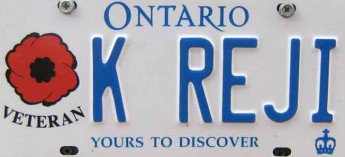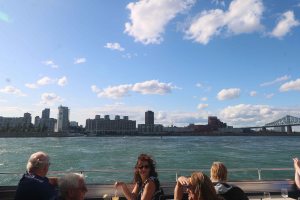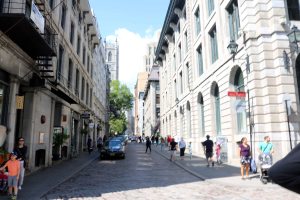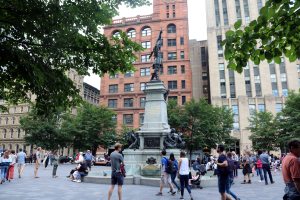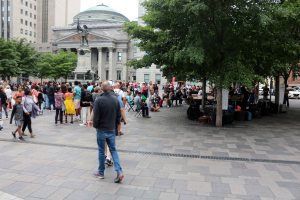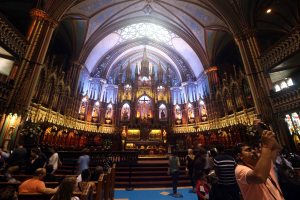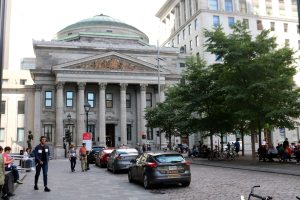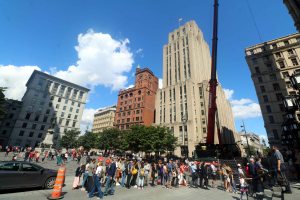From the Place d’Armes square, we embarked on a horse drawn chariot (Calèche) ride with our hostess Sue to explore the area of Old Montreal. The city of Montreal has decreed that Calèches will be off the city’s cobblestone paved pathways from the New Year Day of 2020. There have been cases of horses being mistreated and horses dying while drawing carriages. The lawmakers felt that the resources employed to ensure safe operations of Calèches were causing a heavy drain on its budget. The city plans to replace Calèches with electric vehicles.
Sue, an incessant chatterbox, kept us engaged throughout the tour with her commentary on the history of Montreal and the significance of each street and building, while simultaneously cursing motorists who blocked our way. Most of her ‘constant cacophony’ was historically accurate, but every now and then she came out with something outrageous which indeed needed the proverbial pinch of salt to digest

We rode through Notre-Dame street. On either side were shops selling their wares, mostly to attract tourists. This is a historic street created in 1672 that runs parallel to the Saint Lawrence River. The shops have large entry gates – these were meant for the horse-drawn carriages to pass through.

We came to the Old Courthouse, built in 1857, which today houses Montreal’s financial services.

Adjacent to it stood the modern Palais de Justice or Court House inaugurated in 1971.
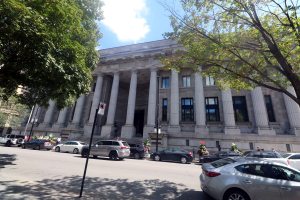
Opposite to the court houses stood the Ernest-Cormier Building of 1926, from where once the Criminal Court operated. The building features monumental granite, limestone and an imposing portico of 14 columns. The building now houses the Quebec Court of Appeal.
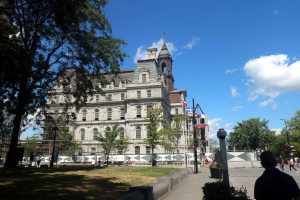
Next we came to the seat of Montreal’s local government, referred to as the Hôtel de Ville de Montréal – an imposing five-story building, constructed between 1872 and 1878.

We then came to Place Jacques-Cartier. By the early 1800s Montreal was expanding and it had outgrown the old market square. In 1803 a fire destroyed dozens of buildings. This newly freed-up space became a public market square, Place Jacques-Cartier. The market operated from here up until the 1950s.
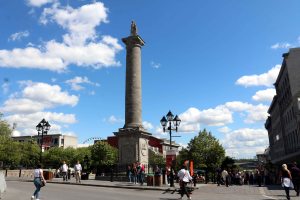
At the North end of the Place Jacques-Cartier stands the Nelson’s Column, about a third of the size of the original. It was erected by Montreal’s Anglophiles to celebrate Lord Nelson’s defeat of the French at Trafalgar in 1805. It is also the city’s oldest monument and is the oldest war monument in Canada. The monument caused plenty of angst and the local government proposed moving Nelson to some far off suburb but newer generations of Anglophiles fought tooth and nail to ensure that the idea was dumped.

Opposite the Nelson Monument is the Francophiles answer to the Nelson’s column, the statue of the French Naval Commander Jean Vauquelin. He fought many battles in the mid 1750s against the British Navy. The Francophiles honoured him with a square bang opposite the Nelsons.
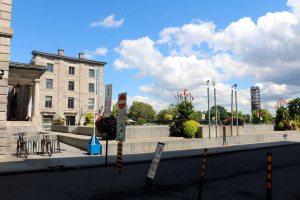
The next point that we saw was the Place du Marché – or market place. Prior to building of the Notre-Dame Basilica and the Place d’Armes square, this was the commercial hub of Montreal and also the gathering spot of the community.
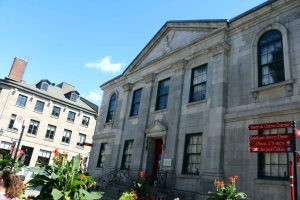
Adjacent to the Place du Marché is the Old Customs House, now part of the Pointe-à-Callière museum. It was called Place du Vieux Marché until 1892. On the 250th anniversary of Montreal’s foundation, it was renamed Place Royale.
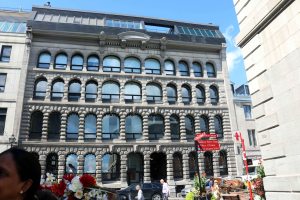
As we rode through the cobblestone paved streets, Sue pointed to this building and said that most buildings in Old Montreal had windows of varying shapes that decrease in size and height with each higher storey. According to her, it was to avoid the ‘Window Tax‘ being levied by the City of Montreal in those days. I could not find any reference to any ‘Window Tax’ in Canada, however, a system of window tax, based on the number of windows in a house was in vogue in England and France. In England this tax was first imposed in 1696, and was repealed in 1851 as it was more of a ‘tax on health, light and air’

This is one of the oldest churches in Montreal, the Notre-Dame-de-Bon-Secours Chapel, also known as the Sailors’ Church, since many sailors prayed here for safe passage. In 1655, Marguerite Bourgeoys, a teacher, in return for her unpaid work, requested the construction of a new chapel dedicated to Virgin Mary. The church was completed 13 years later. This church burned to the ground in 1754 and the present church was built in 1771 over its ruins.

We then rode past one of the first fire stations in Old Montreal, now home to the Museum of Montreal History. The exhibits showcases the history of the building itself and how it transformed from a stable for horse drawn fire equipment to motorised trucks..

Next we came to the Customs House, erected in 1912, is closely associated with the growth of Canadian trade during the first decade of the 20th century. With Its responsibilities enhanced in 1916 with the introduction of direct taxation, this building gained prominence.

This building caught my attention, more for Sue’s commentary. The inscription ‘Grand Trunk‘ and the accompanying GT monogram on this five-storied building indicates that it belonged to the Grand Trunk Pacific Railroad Company. The building was built in 1902 by Charles Hays, the President of the company. Unfortunately, he was aboard the Titanic that sank on 15 April 1912, with his wife, Clara, daughter Orian and son-in-law Thornton Davidson. The materials used are grey granite, beige limestone and chamois sandstone from India.
Sue commented that after the Grand Trunk Company closed down its Canadian operations in 1923 after its acquisition by the Canadian Government, the company moved its operations to India. Again, I could not find any reference to this claim, but possibly the name ‘Grand Trunk’ being a proprietary trade name, could not have been used by the British-Indian Railway, unless the Grand Trunk Company had some association with it. So, Sue may have a point here. The Grant Trunk Express, the legendary train in India may provide the link if any.
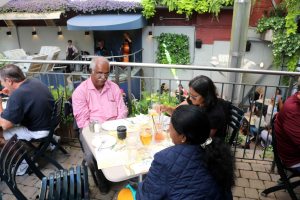
Thanking Sue and tipping her well for her ‘stories’, we alighted from her carriage and walked to Place Jacques-Cartier for lunch. While waiting for the lunch to be served, I booked tickets for a boat cruise along Saint Lawrence River, for a story that follows.
